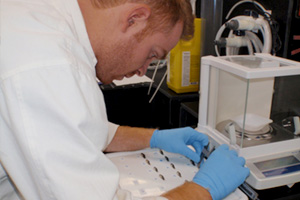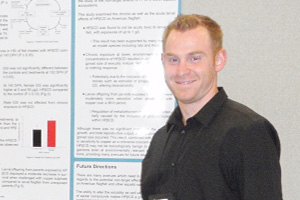UOIT Applied Bioscience PhD student wins top prize at two conferences
December 13, 2013

A University of Ontario Institute of Technology (UOIT) graduate student in the Faculty of Science has pulled off a rare feat by capturing top spot at not just one, but two different research conferences.
Jordan Anderson, a PhD student in Applied Bioscience at UOIT recently received first prize for his Master of Science research at the annual meeting of the Society of Environmental Toxicology and Chemistry (SETAC) North America held in Nashville, Tennessee. He also won first place for his student poster presentation at the 2013 Aquatic Toxicity Workshop (ATW 2013) in Moncton, New Brunswick.
Anderson’s research is investigating the chronic toxicity of hydroxypropyl-beta-cyclodextrin (HPβCD) to fish over a full-life cycle. HPβCD is a commonly used odour-suppressant compound and an active ingredient in household odour-eliminator products.
“Winning first prize at both conferences is unheard of,” said Dr. Douglas Holdway, UOIT Dean of Science, and Canada Research Chair in Aquatic Toxicology. “SETAC is the largest such society in the world and more than 3,000 delegates were at the conference. ATW is Canada’s premier annual conference in Aquatic Toxicity. We are all very proud of Jordan’s achievements, which have brought great prestige to UOIT.”
“It is an honour to have received awards from both ATW and SETAC,” said Anderson. “This achievement represents the incredible support that Dr. Holdway’s Aquatic Toxicology Laboratory and the University of Ontario Institute of Technology’s Faculty of Science provide to its students.”
Anderson’s major findings indicate HPβCD may have reproductive implications in flagfish - a model warm-water fish species very useful in laboratory environments. Flagfish offspring in the lab were less tolerant when exposed to a reference toxicant, specifically copper sulphate. He says more research is needed to uncover the implications of HPβCD within the aquatic environment.



